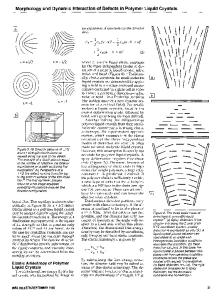Polymer Dispersed Liquid Crystals as Mesoscale 2D and 3D Lattices
- PDF / 706,114 Bytes
- 6 Pages / 612 x 792 pts (letter) Page_size
- 106 Downloads / 334 Views
Polymer Dispersed Liquid Crystals as Mesoscale 2D and 3D Lattices Michael J. Escuti and Gregory P. Crawford Brown University, Division of Engineering Providence, RI 02912 USA ABSTRACT We introduce and explore two- and three-dimensional lattices formed in HolographicPolymer Dispersed Liquid Crystals (H-PDLC) materials, which exhibit an electrically controllable index modulation in multiple dimensions. As electro-optically active holograms, these materials exhibit fast dynamic switching phenomena (~100 microseconds), and are simple to fabricate. While many applications have been proposed for these materials, almost all are based on one-dimensional index modulations in various grating regimes. However, constraints in additional dimensions lead to a much greater sensitivity of the polymer morphology to monomer functionality, exposure irradiance, and grating pitch. In an effort to begin to understand this relationship, two-dimensional triangle lattices were created using two monomeric blends exposed over a range of powers. Final diffraction efficiency (Bragg regime), saturation voltage, and polymer morphology were examined from the resulting triangle lattices. Threedimensional lattices are discussed and a six-beam holographic method is proposed. Photonic crystal applications are envisioned where the pseudo-bandgap can be electrically controlled. INTRODUCTION Photonic crystals have spatially periodic dielectric functions, and are so named in light of an analogy with solid state physics: photons of frequencies within a forbidden band are not allowed to propagate through the material in the same way that the propagation of electrons with particular energies are forbidden in semiconductor crystals if they reside in the energy band gap. The geometry of the pattern as well as the material properties of the substrate control the photonic band structure (the dispersion). Generally, a high refractive index contrast is required for a full band gap (where any polarization in any direction of a particular frequency is prohibited); however, materials with lower index contrasts can find utility in applications where the polarization or direction of incident light is limited in some way. Literature on this topic begins with a paper by Yablonovitch1 and continues to be developed in theory, numerical modeling methods, and devices. The periodicity of photonic crystals may be in one, two, or three dimensions and can be fabricated in several ways. Reactive ion etching, two-photon polymerization, and aluminum oxide films are common approaches. Colloidal
Figure 1: Two-dimensional triangular lattice formed in H-PDLC materials: LC droplets assemble into columns during the holographic exposure, and can be aligned parallel to an applied field. Depending on the LC orientation, radiation propagating in-plane see different index profiles for differing polarizations. K3.6.1
suspensions of opal spheres and polystyrene spheres have been used to produce self-assembled arrays that can be used as templates for a higher contrast material. All of these a
Data Loading...











